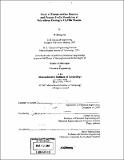Study of plasma-surface kinetics and feature profile simulation of poly-silicon etching in Cl²/HBr plasma
Author(s)
Jin, Weidong, 1975-
DownloadFull printable version (6.634Mb)
Other Contributors
Massachusetts Institute of Technology. Dept. of Chemical Engineering.
Advisor
Herbert H. Sawin.
Terms of use
Metadata
Show full item recordAbstract
This work characterized the Cl2/HBr ion enhanced plasma-surface interactions with poly-silicon as a function of the gas composition, ion energy, ion incident angle and other important process parameters. A realistic inductively coupled plasma beam apparatus capable of generating ions and neutrals representative of real commercial etcher was constructed and utilized to simulate accurately a high density plasma environment. Etching rate of poly- silicon, the oxygen effect and loading effect are quantified to better describe the etching of patterned poly-silicon in fabricating the gate electrode of a transistor in VLSI manufacturing process. The kinetics model derived from these measurements are incorporated into a Monte Carlo based feature profile simulator, and profile evolution has been simulated under various processing conditions. The realistic plasma beam was used to measure the etching yields of poly-silicon with Cl2/HBr chemistry at different ion energies. The etching yields were found to scale linearly with ... where the threshold energies, Eth are 10 eV for both Cl2 and HBr. The etching yields at different neutral-to-ion flux ratio were measured and the sticking coefficients are derived for reactive neutrals for Cl2 and HBr. The sticking coefficient for HBr system is lower probably due to the relatively larger size of bromine atom compared with chlorine and its relatively lower chemical reactivity. The etching yields for mixed Cl2+HBr plasma at different compositions were also measured. (cont.) The etching yield by the HBr plasma beam is similar to the C12 plasma beam, although the etching rate by the HBr plasma is about 40% lower due to the lower ion flux. The angular dependence of etching yield by both Cl2 and HBr strongly suggests the mechanism of ion enhanced chemical etching. With Cl2 plasma beam, the etching yield almost keeps constant until the off-normal ion incident angle increased to 45⁰, while with the HBr plasma beam, the etching yield starts dropping even with small off-normal angle. The etching yield by Cl2+HBr plasma at different composition exhibits a similar trend as pure HBr. The difference of angular dependent etching yield between Cl2 and HBr might contribute to the difference of feature profile evolution in these two chemistries, i.e., more anisotropic etching in HBr plasma, as suggested by Monte Carlo feature profile evolution simulation. The XPS peak for Cl(2p), Br(3d), and Si(2p) are integrated to quantify the relative concentration of different species on the sample surface after exposure to the plasma beam. The Cl coverage after etching with pure Cl2 plasma beam is about 1.4 times higher than the Br coverage after etching with pure HBr plasma beam. The lower Br coverage is likely due to site blocking by coadsorbed H and adjacent adsorption site blocking by the larger Br atom. The Si(2p) was deconvoluted to differentiate Si(bulk), SiCl, SiCl2 and SiCl3. About 70% of the chlorine adsorbed onto the surface is in the form of di- and tri-chloride. Similar results are observed for bromine. Inversion method was used to extract the depth profile from the angular resolved XPS measurement. The halogenation layer is about 15 - 25 [Angstroms] thick, and the concentration of halogen decays exponentially as depth increases ...
Description
Thesis (Ph. D.)--Massachusetts Institute of Technology, Dept. of Chemical Engineering, February 2004. Includes bibliographical references.
Date issued
2004Department
Massachusetts Institute of Technology. Department of Chemical EngineeringPublisher
Massachusetts Institute of Technology
Keywords
Chemical Engineering.